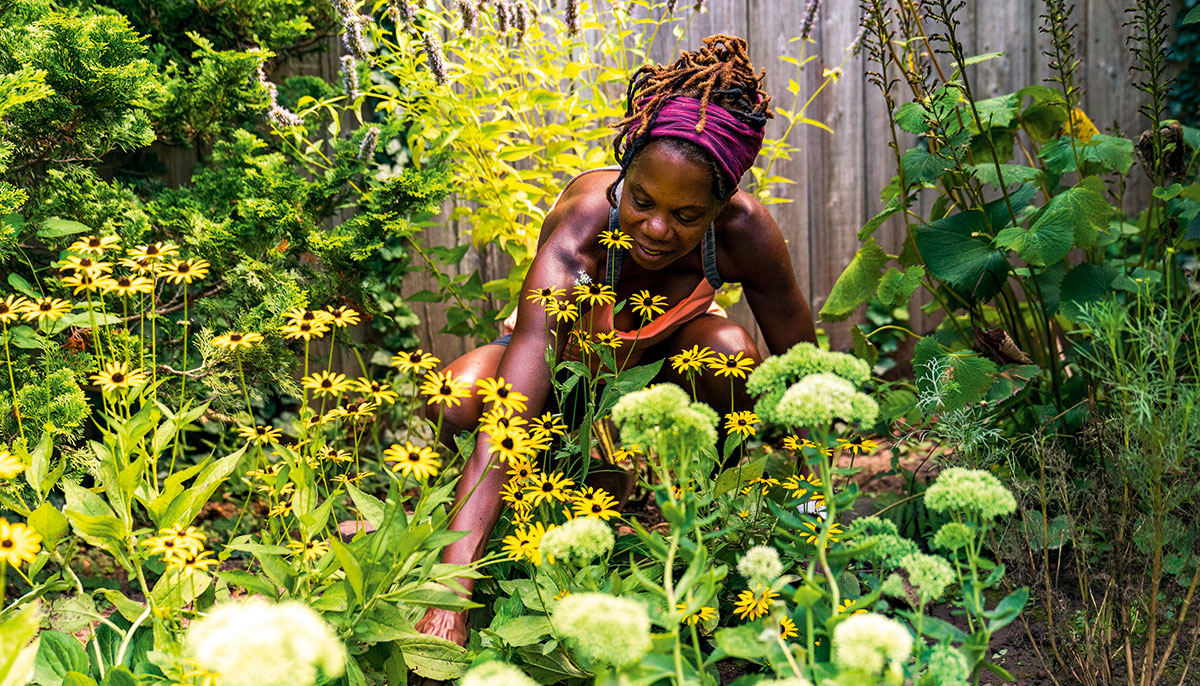“Tell me the landscape in which you live, and I will tell you who you are.”
—José Ortega y Gasset
Growing a garden is an act of love and hope. A garden cannot be planted without them. They are as essential as soil, air, and water for the garden to grow.
My love for growing things began decades ago in northern New Mexico, when I was working as a farm hand at a high desert research farm. There I planted forty pounds of garlic, one clove at a time, surrounded by mesas, pastel-colored canyons, cliffs, grasslands, and streams. I fell deeply in love with soil, air, water, and sky. It was there that I began to realize that to grow a garden, to plant a clove of garlic or a seed, or a tree, is the living theology of love. It is to water seeds of love, peace, and compassion.
The making of this garden taught me to dig deep.
All my life, I’ve been a sucker for beauty. I would rather go without food than without beauty. But for years I was buried beneath the rubble of a life of too much toughness and not enough tenderness. I’d lost sight of love and hope, having spent much of my life trying to make myself into something and someone. I ran from Brooklyn to college, then to grad school, law school, and finally to a big, important job as a lawyer–lobbyist. There was just one problem: the job was killing my spirit.
On a vacation in New Mexico, I finally realized that I was starved for beauty, or at least, I couldn’t see the beauty that surrounded me. A turning point came in the high New Mexican desert. I climbed to the top of a big hill, took off my backpack, and looked up at the sky. For the first time, I truly saw the clouds. I saw the blue sky and noticed how the clouds moved across it. In that stunning moment, I realized that I was alienated not only from the natural world but also from myself. Decades of trying to assimilate as a Black woman into white dominant culture had left me alienated from myself, from my body, from deeper relationships, and from the natural world.
The first foundation of mindfulness is awareness of the body. Mindful awareness invites the practitioner to see, touch, taste, and smell—to be fully alive in the present moment to the great gift of life. Mindfulness is an innate quality in every person that supports awakening to the non-reoccurring nature of each and every moment of daily life. For me, gardening became a theology of love that invited me back to my senses, which were deadened by too muchness, too soon-ness, and too fastness.
Twelve years ago, when my husband David and I moved into a barn-house outside of Philadelphia, I started dreaming about the garden I would plant. But the marriage was choked out by sadness, isolation, and an ambiguous love. David moved out during an excessive heat warning in July, and as he drove away my heart shattered into pieces, activating the seed-like emotions of shame, despair, and isolation. As a lawyer, I knew nothing about compassionate and loving divorce. I had a well-tended adversarial mindset that contributed to the marriage ending. A nagging voice in the back of my head was saying: Dharma teachers don’t get divorced. They live happy, contented, well-rounded family lives.
The divorce was a necessary ending laden with potential. I set out to reclaim my inner gardener—to water the seeds of peace, understanding, and love within me. I replaced rotten wood and painted my barn-house. I removed heaps of junk and diseased trees that threatened to fall on the house. I replaced the cottage roof and painted over graffiti. Then I turned to a small koi pond that at one time had been a source of joy but over the years had become—like my marriage—stagnated with muddy water, overgrown with cattails and arrowheads, and empty of fish. Shovel by shovel, I worked with a couple of friends and helpers to move plants and rocks, remove overgrown weeds, and reclaim the soil with organic matter.
Each month brought a new challenge in the garden: groundhogs, carpenter bees, wasps, and hard-as-rock clay soil. And while the garden was being reborn, my brother was dying. He died in February of last year, and this was followed by desperate months of quarantine, isolation, and physical distance, by the disproportionate impact of Covid-19 on Black, Latinx, immigrant, and low-income communities, by the unlawful police killing of George Floyd and others, and by worldwide protests supporting Black Lives Matter and calling to defund police.
It was a sunny day in July, and it had been nearly one year that I’d been living unpartnered. I walked outside and looked at the place that had not long ago been a hole in the ground with stagnant water. Now there was the sound of running water from a glazed fountain. There were hummingbirds, butterflies, and goldfinches at my Nyjer seed feeder. There was pink Echinacea purpurea, feathery white Artemisia schmidtiana, vivid red Crocosmia hybrid, and lemon yellow Coreropsis verticilata. I went over to the giant staghorn fern and took it down to give it a good watering. Days earlier, I’d noticed that a tiny song sparrow had built a nest of pine needles behind the plant. As I put the nozzle deep into the cavity of the fern, I stopped. There, huddled together, lay five tiny brown speckled eggs.
In the Plum Village tradition of Thich Nhat Hanh, we are invited to wake up to the suffering within and around us—to hold suffering with care, get to know it, and transform it into compassion, peace, and love. We are invited to cultivate a safe haven with each breath for ourselves and for all living beings. The making of this garden taught me to dig deep, deeper still, to know that love is a digger.

